kylemore
Member
- Joined
- 28 Aug 2010
- Messages
- 1,047
I always thought it was a shame they didn't develop the Troon route more. A stone's throw from the A77/M77 within 45 mins from Glasgow as opposed to the slow and tortuous trek to Cairnryan.
Sad to see the Pride of York & Bruges go, I always enjoyed sailing on those as a kid in the 90s as the Norsea and Norsun on Hull - Rotterdam before the newer ferries took over.
Glad the "Prides" have lasted so long. Takes me back to 1987 when my colleagues and I were invited to take a tour of the (then) new Pride of Dover in 1987
 )
)It's long been a naming scheme, largely because "Pride of" is PO i.e. P&O. The Pride of Bruges under discussion here isn't the same as the first ship to carry that name, which was a sister of the ill-fated Herald of Free Enterprise originally named "Pride of Free Enterprise". The whole "Free Enterprise" thing came from the fact that Townsend Thoresen was, at the time, one of the few ferry companies that wasn't in some way Government owned, and was competing primarily with Sealink (BR/SNCF/SNCB), but was dropped after the Herald disaster. The other sister was the Spirit of Free Enterprise which was renamed the Pride of Kent, a name which has also been reused.
The 1987 Pride of Dover was an upgraded version of the Spirit class ships - bigger, but the same very distinctive design with an obvious separate hull and superstructure, as distinct from most ferries which are slab-sided.
(I was a bit of a ferry nut when I was a kid!)
It's long been a naming scheme, largely because "Pride of" is PO i.e. P&O. The Pride of Bruges under discussion here isn't the same as the first ship to carry that name, which was a sister of the ill-fated Herald of Free Enterprise originally named "Pride of Free Enterprise". The whole "Free Enterprise" thing came from the fact that Townsend Thoresen was, at the time, one of the few ferry companies that wasn't in some way Government owned, and was competing primarily with Sealink (BR/SNCF/SNCB), but was dropped after the Herald disaster. The other sister was the Spirit of Free Enterprise which was renamed the Pride of Kent, a name which has also been reused.
The 1987 Pride of Dover was an upgraded version of the Spirit class ships - bigger, but the same very distinctive design with an obvious separate hull and superstructure, as distinct from most ferries which are slab-sided.
(I was a bit of a ferry nut when I was a kid!)
I sailed on the ex Seafrance twins early this year and was very disappointed. They didn't really have any character, just lots of blandly similar rooms. They hadn't even made a feature of the signature double height lobby with huge windows.The two SeaFrance twins were excellent when I used them 12-13 years ago - seemed much nicer than the P&O offering at the time. I've not sailed on either of the Spirits.
I'm glad I'm not the only guy who was a ferry nut as a kid, though I never grew up and get to play with real ones now!
I always thought that there was a lot of irony in the Pride of names, especially when watching the hideously jumboised and rust streaked Pride of Hampshire lumbering into Portsmouth Harbour and wondering if anyone in the county was truly proud of her! A ship that only an accountant could love.
I sailed on the ex Seafrance twins early this year and was very disappointed. They didn't really have any character, just lots of blandly similar rooms. They hadn't even made a feature of the signature double height lobby with huge windows.
As for your comments on the Jumbosized Viking sisters - I thought even accountants could recognise ugliness when it was so painfully obvious haha
I'm glad I'm not the only guy who was a ferry nut as a kid, though I never grew up and get to play with real ones now!
I always thought that there was a lot of irony in the Pride of names, especially when watching the hideously jumboised and rust streaked Pride of Hampshire lumbering into Portsmouth Harbour and wondering if anyone in the county was truly proud of her! A ship that only an accountant could love.
I sailed on the ex Seafrance twins early this year and was very disappointed. They didn't really have any character, just lots of blandly similar rooms. They hadn't even made a feature of the signature double height lobby with huge windows.
It didn't even feel like that to be honest - I couldn't really see any style at all - compared to Stena who do interiors really well, it was just chairs and tables, no variation between the rooms, no warmth, no thought!DFDS are Danish so they have a Scandinavian style interior
It was actually even more complicated than that for the Super Vikings (and two of the original FEs - VI and VII). They kept the original aft part of the hull, with the engine room, and added a new double height vehicle deck above it, with the existing superstructure above that. Forward, the existing hull above the waterline became the new upper vehicle deck, and a new, considerably wider hull was added below. Each pair of sister's new forward hull were launched as a single double ended hull, then cut in half to be fitted to each ship. This left oddities such as lifeboats which were located on original width decks, but above widened sections of the hull, meaning huge frames were added on to ensure that the boats would never hit the hull on the way down. How any naval architect came up with the idea is beyond me, but as you say, very impressive!I was always quite impressed, however ugly they might have been, that you could just lop a slice out of a ferry with a cutting torch and weld an extra bit in! Spirit of Free Enterprise was lengthened in a massive "cut and shut" operation, I believe, though at least that made them look better rather than the ugly addition of an extra car deck to the Vikings.
Did seem very much a Townsend Thoresen thing to do.
It was Sten Olsson, founder of Stena who famously said that ships only look good on the balance sheet, I think it was when he was ordering a similarly hideous jumboisation of a couple of his ferries!As for your comments on the Jumbosized Viking sisters - I thought even accountants could recognise ugliness when it was so painfully obvious haha
It was actually even more complicated than that for the Super Vikings (and two of the original FEs - VI and VII). They kept the original aft part of the hull, with the engine room, and added a new double height vehicle deck above it, with the existing superstructure above that. Forward, the existing hull above the waterline became the new upper vehicle deck, and a new, considerably wider hull was added below. Each pair of sister's new forward hull were launched as a single double ended hull, then cut in half to be fitted to each ship. This left oddities such as lifeboats which were located on original width decks, but above widened sections of the hull, meaning huge frames were added on to ensure that the boats would never hit the hull on the way down. How any naval architect came up with the idea is beyond me, but as you say, very impressive!

 www.doverferryphotosforums.co.uk
www.doverferryphotosforums.co.uk

 www.doverferryphotosforums.co.uk
www.doverferryphotosforums.co.uk
I was always quite impressed, however ugly they might have been, that you could just lop a slice out of a ferry with a cutting torch and weld an extra bit in! Spirit of Free Enterprise was lengthened in a massive "cut and shut" operation, I believe, though at least that made them look better rather than the ugly addition of an extra car deck to the Vikings.
Did seem very much a Townsend Thoresen thing to do.
Stena have altered quite a few vessels. The former Harwich - Hook van Holland pair got lengthened and two of the freight vessels which are now run by Marine Atlantic has a big makeover to add more passenger accommodation before heading to Canada.Isn't that what P&O did with the Darwin twins?
Stena are doing this with the ex Birkenhead to Belfast ferries which are moving to the Baltic.
Btw the Pride of Burgundy is back in service on the Dover to Calais route, apparently since the end of last month.
I think the Darwin conversion left the vehicle decks alone, and just added additional passenger accomodationIsn't that what P&O did with the Darwin twins?
Stena are doing this with the ex Birkenhead to Belfast ferries which are moving to the Baltic.
Btw the Pride of Burgundy is back in service on the Dover to Calais route, apparently since the end of last month.
The Marine Atlantic / Stena conversion was also unique because the ships were shortened - the Marine Atlantic captains had set a limit on the size of ship for the route due to space limitations in one of the ports, and so they cut the ships in half and took a 12m section out of the middle. Stena are very keen on their 'Stenability' concept, which means they design ships to be capable of significant conversions fairly easily, to allow easy charter / sale / redeployment. Their eflexer fleet is a good example - the same basic ship is being used for Portsmouth - Spain and Dover - Calais charters to Brittany Ferries and DFDS respectively - it is difficult to imagine two more different international routes!Stena have altered quite a few vessels. The former Harwich - Hook van Holland pair got lengthened and two of the freight vessels which are now run by Marine Atlantic has a big makeover to add more passenger accommodation before heading to Canada.
According the ships ais the Pride of Burgundy left Newhaven on 24th October and then entered service on the 3rd November.
The 'eflexer' example is really good. Whilst they all look pretty much the same from the outside when you look at some aerial shots of the Stena and Brittany Ferries examples you can see that the former has a car deck where the latter has cabins and more outside space at the rear. The DFDS example will also change this again by having more passenger areas and also being designed for the births at Dover and Calais. The niferry site has a table which shows that the other two Brittany Ferries examples will be powered by LNG and two Stena examples will be longer at 240m rather than 215m.The Marine Atlantic / Stena conversion was also unique because the ships were shortened - the Marine Atlantic captains had set a limit on the size of ship for the route due to space limitations in one of the ports, and so they cut the ships in half and took a 12m section out of the middle. Stena are very keen on their 'Stenability' concept, which means they design ships to be capable of significant conversions fairly easily, to allow easy charter / sale / redeployment. Their eflexer fleet is a good example - the same basic ship is being used for Portsmouth - Spain and Dover - Calais charters to Brittany Ferries and DFDS respectively - it is difficult to imagine two more different international routes!
The 'eflexer' example is really good. Whilst they all look pretty much the same from the outside when you look at some aerial shots of the Stena and Brittany Ferries examples you can see that the former has a car deck where the latter has cabins and more outside space at the rear. The DFDS example will also change this again by having more passenger areas and also being designed for the births at Dover and Calais. The niferry site has a table which shows that the other two Brittany Ferries examples will be powered by LNG and two Stena examples will be longer at 240m rather than 215m.
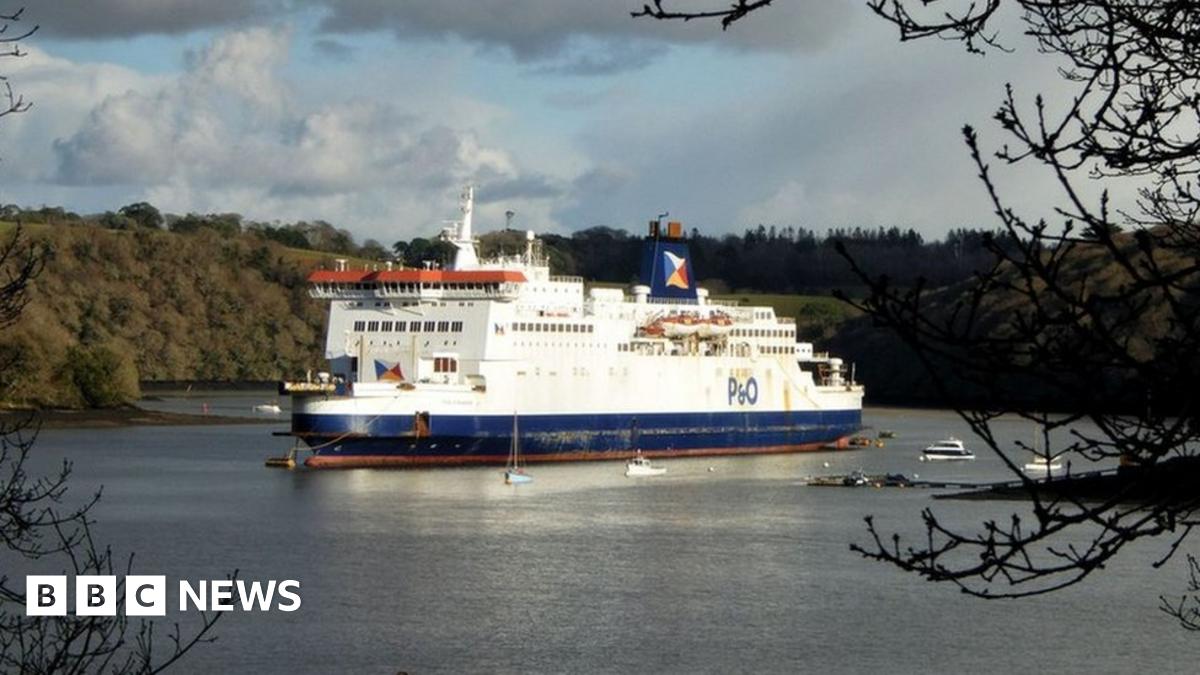
'Favourite' cross-Channel ferry moored on river in Cornwall
Published10 hours ago
Share
Related Topics
IMAGE COPYRIGHTSTEVE ROBARTS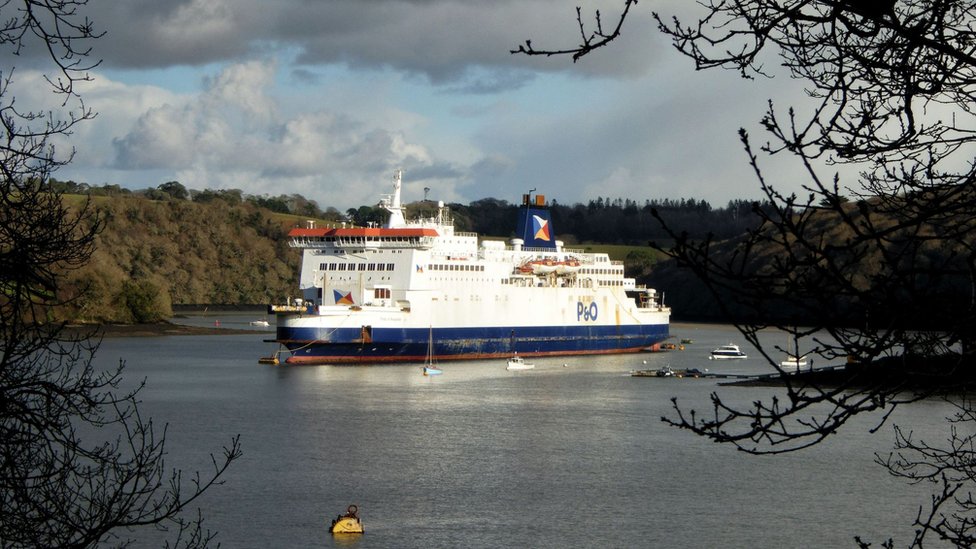
image captionThe Pride of Burgundy is moored on the river Fal and faces "an uncertain future"
A "favourite" cross-Channel ferry that has been taken out of service is now moored on a river in Cornwall.
The P&O Pride of Burgundy served the Dover to Calais route for 26 years but is now on the River Fal near Truro.
Shipping enthusiasts said it was "very sad" the ship they called "the Burg" had been laid up due to the falling demand during the Covid-19 pandemic.
Shipping writer Nige Scutt said "she is a favourite" and feared she may not return to service.
P&O said it was "not providing any details or comments on this matter to the media, at this time".
IMAGE COPYRIGHTDOVER STRAITS SHIPPING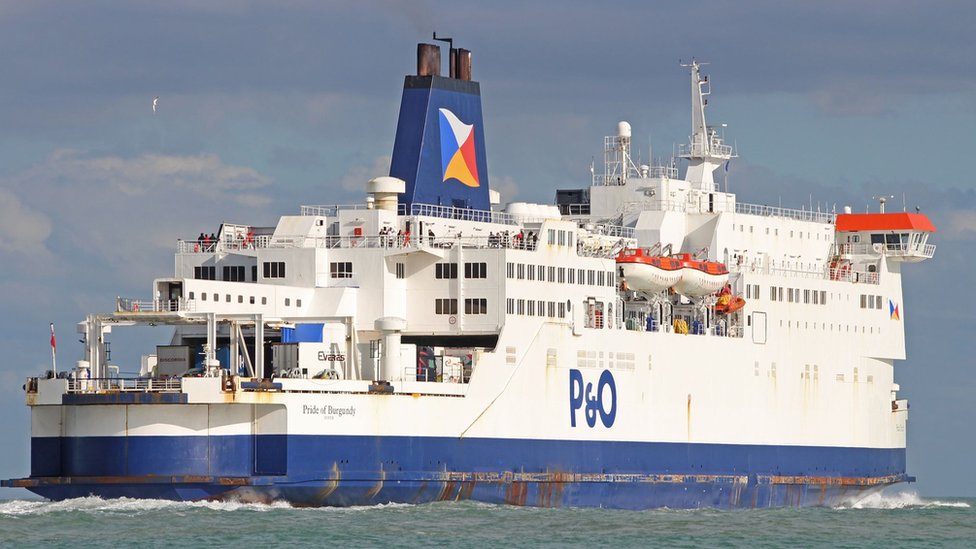
image captionThe Pride of Burgundy is distinguishable to enthusiasts by a black assembly on her funnel they jokingly call her "start handle"
Mr Scutt from Dover Strait Shipping said: "The River Fal has traditionally been where ships go to lay up, and quite often it's the last place we will see well-loved ships before they are sold to a breakers yard.
"She has an uncertain future."
The ferry has capacity for 1,420 passengers and 530 cars according to P&O and served the Dover to Calais route from 1993.
A lack of demand during the coronavirus pandemic saw her taken out of service in May, and laid up in Leith in Edinburgh for several months, before being moved to Cornwall in December.
IMAGE COPYRIGHTSTEVE ROBARTS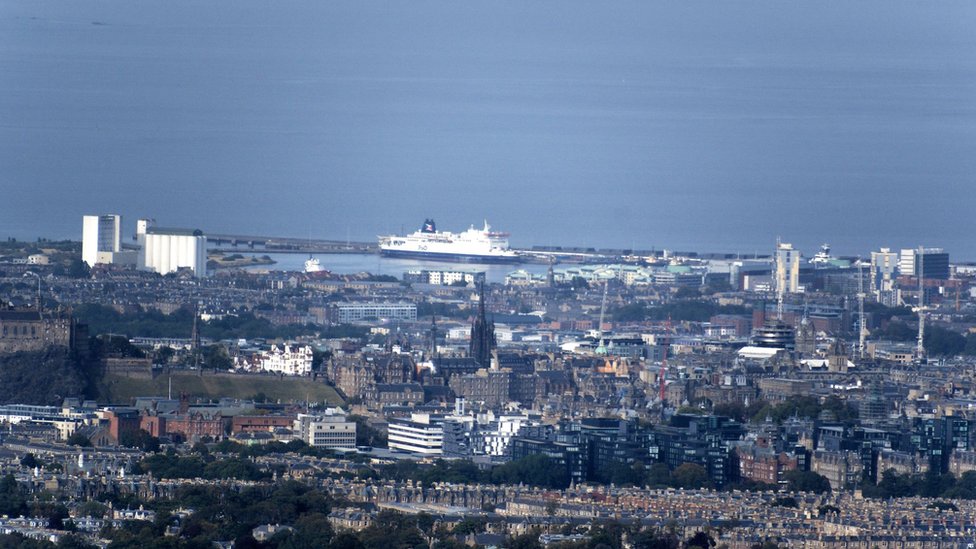
image captionThe ship was laid up in Leith Edinburgh for several months in 2020
Mr Scutt said it was "rather fitting that the Burgundy lays at rest on the upper reaches of the river in such beautiful surroundings".
Explaining her popularity he said: "She was a half-way house. Not entirely freight and not entirely passenger.
"She is unique and that is what has made her one of most people's favourites."
IMAGE COPYRIGHTMARK WILLIS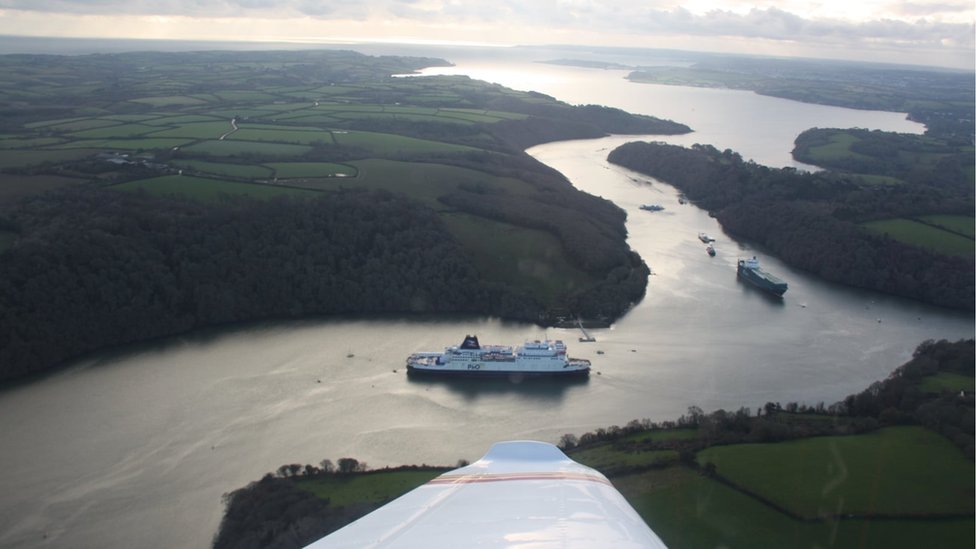
image captionThe River Fal is a popular place for comercial ships to be laid up
The ship had a major refit in 2017, and some crew members had worked on her since she first came into service.
In October P&O announced it was scrapping its service between Hull and Belgium and reducing its cross-Channel services.
Truro harbour master, Mark Killingback, said it was "part of our core business to provide a sheltered location for ship owners to lay up vessels during downturns in trade".
"The port was full in 2007 with vessels after the banking crisis," he added.
P&O seemed to miss the mark more and more as time went on, mores the pity.
